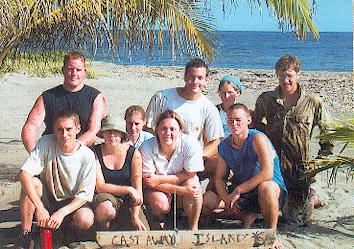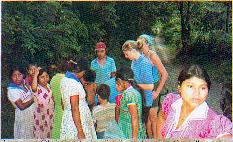Multi-activity expedition 'Guacamaya' to Guatemala and Honduras - September 2001
Dorset & Wiltshire Wing Air Training Corps
 On
September 6th, nine cadets and four staff arrived in Guatemala City to be told
that our planned expedition programme had been scrapped and Plan "B"
was in effect. The site of the base camp for the expedition was to have been at
the village of Paso Caballos in the Paten Region of Guatemala. However the tribe
of KekChi Indians had decided to go "walkabouts" and the village was
now deserted and not a nice place to visit.
On
September 6th, nine cadets and four staff arrived in Guatemala City to be told
that our planned expedition programme had been scrapped and Plan "B"
was in effect. The site of the base camp for the expedition was to have been at
the village of Paso Caballos in the Paten Region of Guatemala. However the tribe
of KekChi Indians had decided to go "walkabouts" and the village was
now deserted and not a nice place to visit.
Plan "B" involved travelling by road to Puerto Barrios on the Caribbean coast of Guatemala. We then took a small boat to a remote research station by the village of Punta Manabeque. The station was very remote with 26 miles by sea to the nearest town in front, and 200 miles of rain forest behind - our own private desert island. Here we spent the next eight days helping at the research station and playing "castaway" - not what we had expected, but certainly adventurous.
Fortunately, we had planned for isolation, and had come prepared with all the right gear, from tentage and multi-fuel cookers, to water purification equipment. With water being delivered every two to three days, weather permitting, the water filters proved very useful. We has also taken along 40 ration packs for use in emergencies. After a few days of isolation, a ration pack can be very inviting, even "biscuits brown".
After the eighth day, everyone was ready to return to some form of civilisation. We left our "island" and headed for Quirigua where we were to work on the Commonwealth War Grave of Major R S Turton, RAMC, who had died in Guatemala in 1919 while helping with an outbreak of Cholera. For two days we worked to replace and renovate the grave.
 Whilst
at Quirigua, we were told of a village, in the mountains about 40 miles away,
where due to a drought, children were dying of starvation. We decided to put
together any money we could afford and buy enough food for the villagers to live
on until the arrival of aid relief agencies. We managed to purchase a truck load
of food, and travelled into the mountains to deliver it to the village. The
welcome we received will live with us forever - the look of despair on the
children's faces changing to smiles when we arrived was unforgettable.
Whilst
at Quirigua, we were told of a village, in the mountains about 40 miles away,
where due to a drought, children were dying of starvation. We decided to put
together any money we could afford and buy enough food for the villagers to live
on until the arrival of aid relief agencies. We managed to purchase a truck load
of food, and travelled into the mountains to deliver it to the village. The
welcome we received will live with us forever - the look of despair on the
children's faces changing to smiles when we arrived was unforgettable.
On our return to Guatemala City, the Embassy stall had arranged with Medicine Sans Fronteras, an Aid Agency, to take us to see the main city rubbish tip. We were all wondering why until we arrived and found that there are 300 families living and surviving on the tip. People are born there and die there, with no hope of ever leaving. We shall never forget the sights and smells.
We also visited the Maya ruins at Copan in Honduras and were privileged to attend a reception held on our behalf by the British Ambassador to Guatemala.
Overall, we were left with lasting impressions of life that most people will never see. I am sure the experience has changed us all for the better.
WO Keith Child